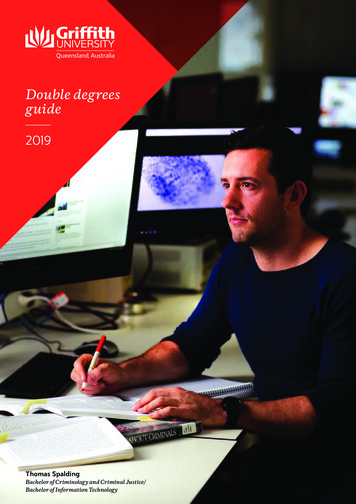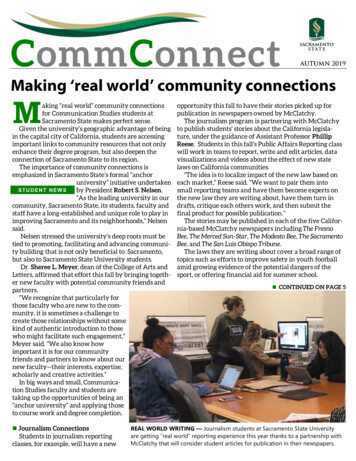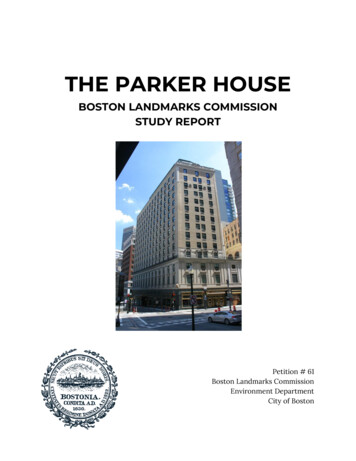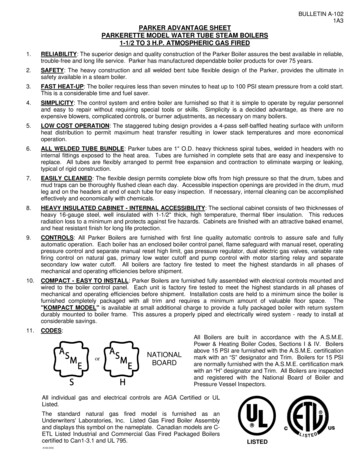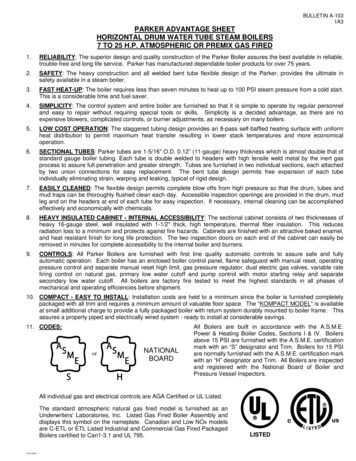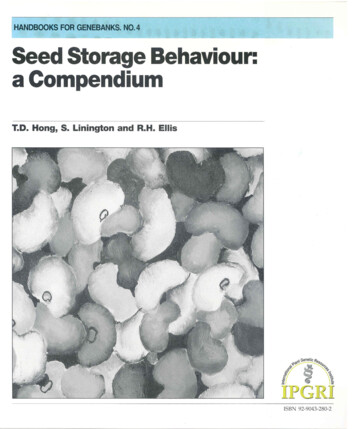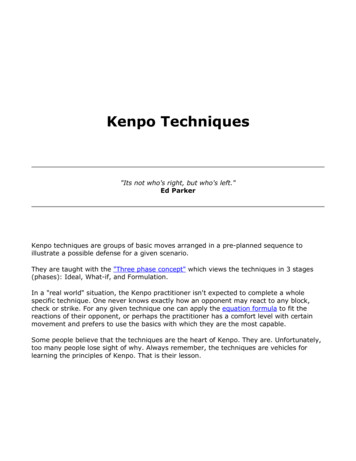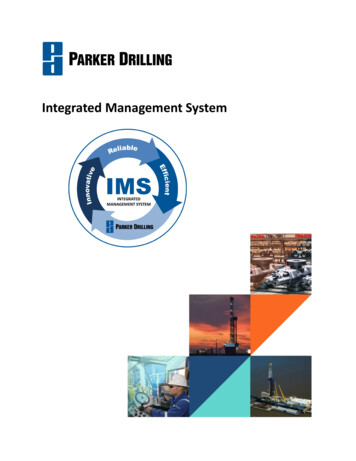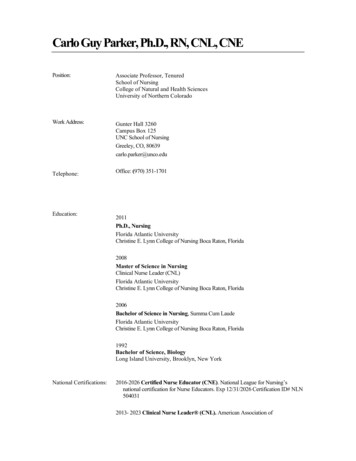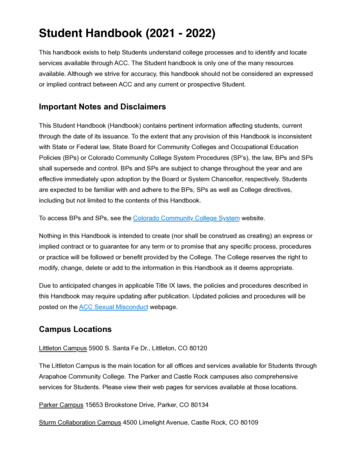
Transcription
A survey of park user perception in the context of green space and city liveability:Lake Claremont, Western Australia.Jackie ParkerBachelor Behaviour Studies (Psychology), Swinburne UniversityGraduate Certificate Protected Area Administration, Murdoch University12 point thesis in partial fulfillment of:Master of Environmental ScienceSchool of Veterinary and Life SciencesMurdoch UniversityNovember, 2017
AbstractThis project was undertaken to gather information about visitors’ experience andsatisfaction levels across various established public open space features whenvisiting Lake Claremont, Western Australia. Within diminishing opportunities foracquisition of new public open space, the efficient management and continuousimprovement of existing public open space sites is crucial. To gather the visitorinformation, an intercept survey (n 423) was undertaken revealing that a strongmajority of visitors perceived the public open space as high performing and werevery satisfied with most of the current public open space features. Using theImportance-Performance Analysis tool (IPA), the information collected was furtherinterrogated to reveal areas where servicing levels at the site were not congruentwith the visitors desires or expectations (over-servicing or under-servicing). Thisproject reveals how this information can be used from a land owner/managersperspective to increase the efficiency of site management, help inform levels ofservice as well as direct future management decisions. This project can also act asa blueprint for the land owners/managers of other public open space sites to gathersimilar information, with the ultimate aim of improving the opportunity and quality ofpublic open spaces with considered use of resources.2
Research DeclarationI, Jacqueline Parker, declare that the Master of Environmental Science projectthesis entitled ‘A survey of park user perception in the context of green space andcity liveability: Lake Claremont, Western Australia’ is no more than 10,000 wordsexclusive of tables, figures, appendices, references and footnotes. This thesiscontains no material that has been submitted previously, in whole or in part, for theaward of any other academic degree or diploma. Except where otherwise indicated,this thesis is my own work.Signature:Date:3
Table of ContentsAbstractPage 2Research DeclarationPage 3AcknowledgementsPage 5List of Figures and TablesFigure 1 – Gender Distribution.Page 17Figure 2 – Location Distribution.Page 18Figure 3 – Activities Participated In.Page 18Figure 4 – Axis Centred IPA.Page 20Figure 5 – Data Centred IPA.Page 22Table 1 – Public Open Space Features, Mean Importanceand Satisfaction Scores.Page 19Table 2 – Prioritisation for Management Investigation andAction.Page 22Introduction and Research ContextPage 5Targeted Literature ReviewPage 10MethodologyPage 15ResultsPage 16Part One – Descriptive StatisticsPage 17Part Two – Importance Performance AnalysisPage 19DiscussionPage 23Implications of resultsPage 24Changing values and expectations of site usersPage 28Land owner/manager responsibilitiesPage 28Frequency of surveyingPage 29Limitations of this projectPage 30ConclusionPage 31ReferencesPage 32Appendix 1 - SurveyAppendix 2 - Standard Confidentiality LetterAppendix 3 - Information SlipAppendix 4 - Literature Review Methodology4
AcknowledgementsA special thank you to Greg Simpson for his assistance in survey collection andsupport throughout the project, the Friends of Lake Claremont for their on-goingsupport and collaboration and the Town of Claremont for the permission to use LakeClaremont as the research site.Introduction and Research ContextPublic open spaces, in many shapes and forms, exist all over the world.These spaces afford us many opportunities, such as chances to exercise, playsports, socialise, relax, learn, and experience nature. These spaces are beneficialfor our psychological health, physiological health and have been shown to improveour outlook on life (Keniger et al. 2013; Conteh and Oktay 2016).Wider social and environmental benefits are provided by public open space(Balram and Dragicevic 2005; Grose 2009; Nasution and Zahrah 2014; Van DenBerg et al. 2007; Hughes 2014; Bratman et al. 2012; Keniger et al. 2013; Cattell etal. 2008). These benefits include enhanced environmental management ofunderutilised or degraded natural assets, increased conservation efforts of new andexisting public spaces and natural assets, micro-climatic advantages which helps tobuild resiliencein highly urbanised cities, and habitat creation and/or improvement.Newton (2012) suggests that further development, utilisation and support of urbanpublic open spaces, and alternative urban design opportunities, will contribute tobuilding a future which is livable, environmentally sustainable and resilient.With the continuation of population growth in cities, such as Perth, WesternAustralia, the opportunities for creating new public open spaces is limited. Withlifestyles that are increasingly psychologically demanding, preliminary trends ofclimate variability already evident and increasing social disconnection; theprotection and acquisition of quality public open space, has never been so critical(Keniger et al. 2013).To cater for the current and future needs and desires of public open spaceusers, a substantial effort must be made to understand how public open space sitesare being used, the visitor perceptions while at the sites and how public open space5
features contribute to a successful visit. With this information, the creation andongoing management of public open spaces can be enhanced for the users.A practical, efficient, and widely accepted technique to gain informationpertaining to experience, expectation, satisfaction, and values is via social surveys.Social surveys have successfully been tried and tested across many disciplines andfor many purposes. Questionnaire surveys allow for quantitative and qualitativeinformation to be extracted from participants in an efficient way, which can then belater analysed (Dallimer et al. 2012).This project utilises a custom designed survey to collect qualitative andquantitative information from park visitors to capture information about their visit,value placed on different public open space features, their perception of sitemanagement and overall satisfaction of the site. The site chosen for the project isLake Claremont, Perth, Western Australia.The way in which we choose to spend our recreational time is an importantdecision. In 2006, Australians reported having approximately four hours ofleisure/recreational time every day (ABS 2006), however, not all time investmentshave the same return (Smith and Oyserman 2015). For example, individualdifferences aside, investing time into re-watching movies will not provide the samereturn as investing time building quality relationships with friends and family,experiencing nature or learning something new (Smith and Oyserman 2015). Howwe decide to spend our leisure time can impact our quality of life, the perception ofthe life we lead, the perception of the city in which we live, and our psychologicaloutlook on life (Smith and Oyserman 2015; Lin et al. 2014).Researchers such as Lin et al. (2014), posit that with increased urbanisationthe understanding of urban public open space use is imperative to a happy, healthyand functional future for city residents. Lin et al. (2014) suggest that both theopportunity for public open space experience as well as the orientation of the spaceis crucial for the quality and quantity of the experience for visitors (Lin et al. 2014).This means that we need diverse public open space sites that are available for us,both in proximity and as well as fair/equal access.When determining the quality in quality public open space, the followingseven areas appear consistently throughout current literature in the urban publicopen space domain; functionality, fair and equitable access, conservation andenvironmental education, water sensitive management, meeting social needs,infrastructure and amenities (Villanueva et al. 2015; Irvine et al. 2009; Giles-Corti et6
al. 2005; Antognelli and Vizzari 2017; Shanahan et al. 2015; Taylor et al. 2011). Thelevel of performance of public open space features gives an indication of the overallquality of a location. Examples of high performance among features may includeconsistent universal access across the site including infrastructure (picnic tables,playgrounds), use of water sensitive turf and plants, and a practicable site layoutwith installations that meet the current needs of site users. Each of the seven areasabove contribute to the visitor experience of a public open space site. Together, it isagreed that they create a foundation of the visitation experience of a typical urbanpublic open space (Villanueva et al. 2015; Irvine et al. 2009; Giles-Corti et al. 2005;Antognelli and Vizzari 2017; Shanahan et al. 2015; Taylor et al. 2011).Understanding the experience and expectations of public open space users isessential for quality site management and planning, continuous managementimprovement, increasing and supporting current patronage as well as to draw anyconclusions of how these spaces are psychologically and physiologically affectingusers.In addition, factors harder to quantify, and measure, also affect visitor’snature experience and urban public open space experience. An example being‘tranquillity’; the tranquillity of urban public open spaces has been linked withpsychological and spiritual benefits (Watts 2017). Watts (2017), developed a toolknown as Tranquillity Rating Prediction with the purpose of measuring the level ofman-made noise as well as the existing natural elements of public open space(Watts 2017). Based on this research it is suggested that tranquillity can be createdand enhanced; ultimately controlled by limiting human made noise such as traffic,improving aesthetics such as increasing tree planting, installing natural featuressuch as ponds and lakes, and reducing aesthetically displeasing elements such asrubbish (Watts 2017). Increasing the tranquillity of public open spaces has beenfound to increase the performance of a site and likely increase the level ofsatisfaction experienced by visitors (Watts 2017).The concept of city ‘liveability’ emerged in the 1980’s, and refers to thequality of citizen life determined through the assessment and ranking of potentiallyinfluential characteristics (Jones and Newsome 2015; Okulicz-Kozaryn 2011;Newton 2012). These characteristics are reported to include, but are not limited to,climate comfort, quality of and access to education, cost and availability of housing,quality of and access to health care,stability of political systems, quality of andaccess to public transport and affirmation of human rights. These characteristics areassigned a value then consolidated into a final score which is ranked against other7
cities around the world. Currently, two prominent global city liveability scales areproduced annually; one by the Economic Intelligence Unit (EIU) based acrossBritain, and the second by Mercer based in London. Both liveability scales feature inprominent media reporting and are utilised in selling the attractiveness of a city as aplace to live (Jones and Newsome 2015).Cities with high ranking liveability scores are sought after and can providewider social and economic benefits. These benefits can include foreign businessand housing investments, local and international economic stimulus, increased localcommunity involvement and an increase in individuals’ sense of pride (The Value ofRankings and the Meaning of Liveability 2014), and an increase in tourism (Newton2012). These benefits are particularly important to cities that rely on internationaleconomic stimulus (such as tourism) rather than local economic stimulus (such asretail).The perception of city liveability is as important as the reported ranking ofcity liveability. Citizens that perceive a city to be highly liveable are more likely toengage, experience and enjoy the benefits that the city can offer (Jones andNewsome 2015; Okulicz-Kozaryn 2011). Understanding what contributes to theperceptions of city liveability is essential if a true and equitable concept of cityliveability is to be realised. Currently the subjective elements, such as opportunitiesfor nature experiences, environmental education, and opportunities for visitingquality public open spaces are under-represented (Jones and Newsome 2015). Thismay be due to the poor understanding of these elements, the difficulty in quantifyingand assigning a score, and the difficulty in verifying their associated performance.The subjective elements that may contribute to city liveability could include how acity protects fragile ecosystems, answers to climate change, funds environmentaleducation programs, and addresses resource recovery and waste. It is posited inthis thesis that the presence and prevalence of high quality public open spaces area contributor to the perception of city liveability.The capital city of Western Australia, Perth, has a population of 2.59 millionpeople (Australian Bureau of Statistics 2017) and consistently features among theworld’s most liveable cities (Jones and Newsome 2015; Economist Intelligence Unit2016), making Perth a suitable liveability research location. Perth has not alwaysvalued and protected natural assets such as wetlands and open water bodies(Government of Western Australia 2016; Simpson and Newsome 2017). Predevelopment/colonisation, Perth featured an extensive network of wetlands8
(Government of Western Australia 2016) and since the 1820’s, many of thesewetlands have been lost to development and ever-expanding infrastructure(Government of Western Australia 2016).Lake Claremont, the chosen study site, is located 10 kilometres South Westof the Perth CBD. The mixed-use (passive, active and natural areas) site coversapproximately 60 hectares and under the WA Environmental Protection Policy(1992) Lake Claremont is listed as a Conservation Category Wetland. LakeClaremont is also a nominated Bush Forever site by the Government of WesternAustralia and protected via the Wetlands Conservation Policy through theEnvironment Protection Biodiversity Conservation Act 1999. Lake Claremont is amultifaceted open space and includes major revegetation efforts, a golf course,playgrounds, open turf spaces, a dog exercise area, BBQ facilities and is a localbiodiversity hotspot (Simpson and Newsome 2017). Lake Claremont is unique in itscontribution to the local and wider community providing many recreationalopportunities which are carefully balanced with (competing) conservation values(Simpson and Newsome 2017). Due to its inner-city location, high patronage, andmix of natural and anthropogenic values, Lake Claremont is a valuable public openspace research site.Despite large scale visitor satisfaction surveys pertaining to urban wetlandsbeing limited in the current literature, the recognised benefits of surveying areextensive. These benefits include better decision-making capabilities, strengtheningsupport for infrastructure installations, upgrades, removals and prioritisation for landowners/managers, facilitating better environmental, conservation and educationaloutcomes, better meeting the needs and desires of the site users and enhancingopportunities for mental and physical wellbeing (Jennings 2001).When determining the appropriate research questions for this project,several considerations were made. Firstly, the research must contribute to animproved approach to public open space management. Secondly, visitor informationmust be efficiently collected, analysed and interpreted to provide meaningful,insightful and previously unknown information to inform better management of thesite. Lastly, the research must be suitable for replication at other sites to allow forcomparison analysis and/or benchmarking.Based on these considerations, the following research questions wereselected for the project:1. How satisfied are visitors with the Lake Claremont site?9
2. Do visitors regard Lake Claremont as a high quality public open space?3. Does high quality public open space increase the perceived liveability of Perth asa city for visitors at Lake Claremont?To provide clarification within the context of this paper, the following terms aredefined as follows:Experience: The observation of or participation in events.Perception: Using the senses or mind to assign value or experience to.Expectation: Looking forward to or anticipating something.Importance: The degree of significance placed on an item.Satisfaction: The level of fulfilment of a need or want.Performance: The efficiency in which something fulfils its intended purpose.Targeted Literature ReviewIt is estimated that around 54.5% (4.05 billion) of the world’s populationcurrently live in cities. By the year 2030, this figure is expected to increase to 60%(5.1 billion) (United Nations 2016; United Nations 2015). Living in highly urbanisedenvironments can result in diminished opportunities to experience nature, and theassociated benefits. Public open space sites within urbanised areas are thereforecrucial to arrest any further disconnect between individuals and nature (Sogaa et al.2015). Researchers such as Sogaa et al. (2015) advocate for the need to increasethe value placed on quality public open spaces, particularly in highly urbanisedareas, to halt the disengagement of people with the surrounding natural world.Australia is not immune from the challenges presented by urbanisation andpopulation growth. Australia is the seventh largest continent in the world and ishome to over 23 million people. The majority of Australians live in cities on thesouth-western coast and the south-eastern coast. Australia’s population has beensteadily increasing by 2-3% annually (ABS 2013). This population growth is basedon both natural increase (aging population, higher birthing rates) and migration(ABS 2013). Perth, as a city, now expands over 200kms in length with a populationof over two million people (ABS 2013). Expansion in Perth is currently based uponincreasing living densities as well as furthering the urban sprawl.In 1955, a report titled ‘Plan for the Metropolitan Region Perth andFremantle’ (also known as the Stephenson-Hepburn Plan) proposed the10
requirement of 3.36 hectare of public open space per every 1000 people. In morerecent times, this proposed requirement has been translated into a figure of 10% ofland development being allocated to public open space. This percentage features incurrent Western Australian planning policy (Western Australian PlanningCommission 2002) and gains a mention in the Department of Sport and Recreationguides (Department of Sport and Recreation 2013). This 10% public open spacerequirement has acted as a guide for developing suburbs and has been achieved inmany instances. As population densities increase, this 10% allocation is becomingstrained, in some instances this allocation no longer accommodates the local needs(such as planned and unplanned sports) and in other cases is now unachievablewhere the correct planning provisions were not made (Grose 2009). The strain onpublic open space availability is coupled with the trend of reduced size backyards,ongoing bushland clearing and continued sprawling development of cities (Grose2009); all factors limiting opportunities for local recreation and outdoor activities.At the same time, public open space research is receiving more attention byscholars, health professionals, planners, urban designers and citizens. Tangible andintangible benefits are realised from quality public open spaces; some wellunderstood, and some poorly understood. Significant psychological, physiologicaland environmental benefits of public open space have been well documented(Dallimer et al. 2012).When exposed to the natural environment and urban public open spaces,we experience a change within ourselves; our psyche. Multiple psychological,physiological and biological factors are responsible for this change (Balram andDragicevic 2005; Grose 2009; Nasution and Zahrah 2014; Van Den Berg et al.2007; Hughes 2014; Bratman et al. 2012; Keniger et al. 2013; Cattell et al. 2008).Quantifying these factors has been a focus for neurophysiologists and sociologists,to better understand our responses and to facilitate the natural, organic benefits thatpublic open space provides. Engaging with the natural environment allows us toconnect with ourselves, with others, to experience wonder and to inspire us whichrepresents a marked psychological change (Cracknell et al. 2016). In a time that weare highly connected through rapidly progressing technology and highly demandingand competitive working environments, capitalising on opportunities to engage withthe natural environment for psychological benefit has never been so important(Cracknell et al., 2016).11
Research into physiological improvements of individuals who engage withthe natural environment is rapidly progressing. An increase in physical activity,improved physical fitness, improved cardiovascular health and an improvement inchildren’s agility and spatial negotiation skills are just some of the documentedbenefits (Public Open Space 2017; Nasution and Zahrah 2014). Researchers suchas Gladwell et al. (2013), advocate that exposure to nature and nature experienceshas physiological (and other) benefits for individuals such as stress reduction,improvements in mood, restoring mental fatigue and changing the perception of wehave of our own physiological health. It is also suggested that exercising within thenatural environment requires lessened exertion when compared to exercisingindoors (Gladwell et al. 2013).Findings from a study in Japan by researchers Li et al., (2011) are congruentwith Gladwell et al. (2013) (United Kingdom), which found that those who partook inphysical activity within a forest environment, which Spechet (1970) defined as anarea with 30% or more canopy cover, tended to exhibit significant physiologicalimprovements in immune function, a reduction in stress hormones, fatigue and thesympathetic nervous system function, and showed an increase in theparasympathetic nervous system function. The participants of this research werereported to have experienced these benefits after spending only two hours in aforest environment (Li et al. 2011).Cracknell et al. (2016), presents the idea that bodies of water can make ushappier, healthier, more connected and better at what we do. They state that waterassets of all descriptions; natural (rivers, lakes, oceans) and man-made (fountains,water playgrounds, features) can produce a calming, peaceful and unified mentalstate which in turn increases one’s general sense of happiness and satisfaction withlife in that moment. Cracknell et al. (2016) describes water and nature experiencesas a natural, organic medicine that can reduce stress, increases creativity andfacilitates close relationships. The awe and wonder that individuals can (often)experience while being near to water bodies (natural or made-made) is said to beginthe psychological and physiological response which is where the benefits arederived.Applying the systematic quantitative literature review techniques, a total of75 original, peer reviewed papers on public open space and city liveability wereidentified. Several trends were identified in the reviewed papers; 43% proposed anew tool or methodology (new public open space quality assessment tools, new12
data collection methods or suggested improvements to existing liveability and publicopen space assessment tools). A large 87% reported the use of qualitative datacollection methods (surveying with open ended questions, in-depth interviews withparticipants, observations and focus groups) and 73% reported the use ofquantitative data collection methods (observations/recording of frequencies,surveying with scales or closed questions and computer generated data). It wasnoted that 40% of the papers utilised GIS technology, 89% focused on socialaspects (sense of community, social needs, social issues, social services andissues that are people focused), and 67% on health and wellbeing (communityhealth, personal health, physical health, mental health and trends of improving ordeclining health populations). Additional focus areas/concepts that were engaged inby the authors of the papers reviewed, included Quality Open Space (65%),Liveability (65%), Environmental and/or Ecological (59%), Planning and/or Policy(56%) and Economic (52%).Confidence in connecting contributing factors to increased city liveability isdifficcult, which in part explains the lack of clear data summarising the objectiveliveability elements as well as the subjective elements. Of the 75 papers assessed,57% suggested a link between Quality Public Open Space and increased CityLiveability and 40% suggested a link between Biodiversity and/or EcologicalOpportunities and increased City Liveability. The remaining four items wererecorded as follows; Public Open Space Infrastructure 33%, Easy Access to PublicOpen Space 32%, Walkability 19% and Tree canopy cover 17%.In regards to the research effort on public open space and city liveability,37% of papers claimed there was a lack of research around their chosen focusand/or topic. A further 35% of papers also suggested further research is requiredand made various recommendations as to the direction the research should take.This information is important when determining the current research/knowledgestatus of the discipline and future research that is required to progress the disciplinein a measured and quality driven way. The papers found on public open space andcity liveability were contained within a variety of disciplines. This demonstrates thatthis emerging field must be viewed as being multidisciplinary in nature with the needto derive learnings and existing research from the various disciplines.For the purpose of this study, the researched reviewed assisted in identifyingimportant public open space features that contribute to an individual’s perception oftheir public open space experience. These identified features assisted in the13
creation of the survey used within this project to test the values, views andsatisfaction levels of participants. The features were grouped into the followingseven categories with assertions of how the performance of the feature can beassessed;FunctionalityThe space caters for the needs of those in the local catchment area as wellas those in wider catchments. The public open space facility can provide multiplefunctions that work seamlessly together, including recreation spaces, playgrounds,meeting spaces, nature spaces and relaxation spaces.Fair and equitable accessAll patrons have access to the public open space facilities in both distance toand from public transport/parking facilities and universal access needs. Effectiveconnectivity exists between local and regional public open spaces to support theuse of sustainable movements as well as creating vital fauna linkages (canopycover of trees, appropriate tree species selection).Conservation and environmental educationQuality interpretive information on conservation and environmental issuesare provided and considered throughout the lifespan of the space. This informationis presented in a way which is easily understood by a range of demographics and isdesigned to fit specifically within the context of the space.Water sensitive managementWater resources are responsibly managed to support and allow for ongoingquality public open space maintenance. Water sensitive management actions occurincluding water saving irrigation design and technology, using low water demandturf/plants, grouping areas within the public open spaces based on waterrequirements and using water saving horticultural practices where practical.Meeting social needsFormal and informal facilities are provided to support and encourage parkpatrons to socialise in a safe and secure space. Social needs are met within achanging population and the needs of a wide demographic are catered for.Infrastructure14
Paths, fences, lighting, playgrounds and other installations are maintained toa high standard and are seamlessly upgraded as they meet the end of their usefullife. Existing infrastructure provides a safe environment for patrons to effectivelyrealise the benefits of the space.AmenitiesToilets, drinking facilities, barbeque and furniture installations are accessibleto park patrons and meet the desires and needs of the patrons.MethodologyThe literature review contained in this thesis, guided by Pickering and Byrne(2013) (methodology included as Appendix 4), was undertaken to appraise thecurrent research and knowledge around quality urban public open space, visitorsatisfaction findings, visitor experience information and noted public open spacecontributions (social, economic, and environmental). The literature revealed several(somewhat) universally recognised park features, such as access paths, open turfareas, seating, infrastructure, and playgrounds. These universally recognised parkfeatures were assessed in terms of their presence and suitability of use at the LakeClaremont site, and assisted in the construction of the social survey.Twenty-two park features were selected for the survey after considerationwas given to the context of the research site. Each feature selected was used to testthe survey participants’ perceived importance level as well as performance level.Analysing this information enabled the establishment of user satisfaction indices ofthese features, as well as the site as a whole. Utilising universally recognised parkfeatures allows for enhanced application of this research as well as any potentialfuture comparative research across similar sites.A Power Analysis was undertaken prior to
Lake Claremont, Western Australia. Jackie Parker . Bachelor Behaviour Studies (Psychology), Swinburne University . Graduate Certificate Protected Area Administration, Murdoch University . 12 point thesis in partial fulfillment of: Master of Environmental Science School of Veterinary and Life Sciences Murdoch University November, 2017
